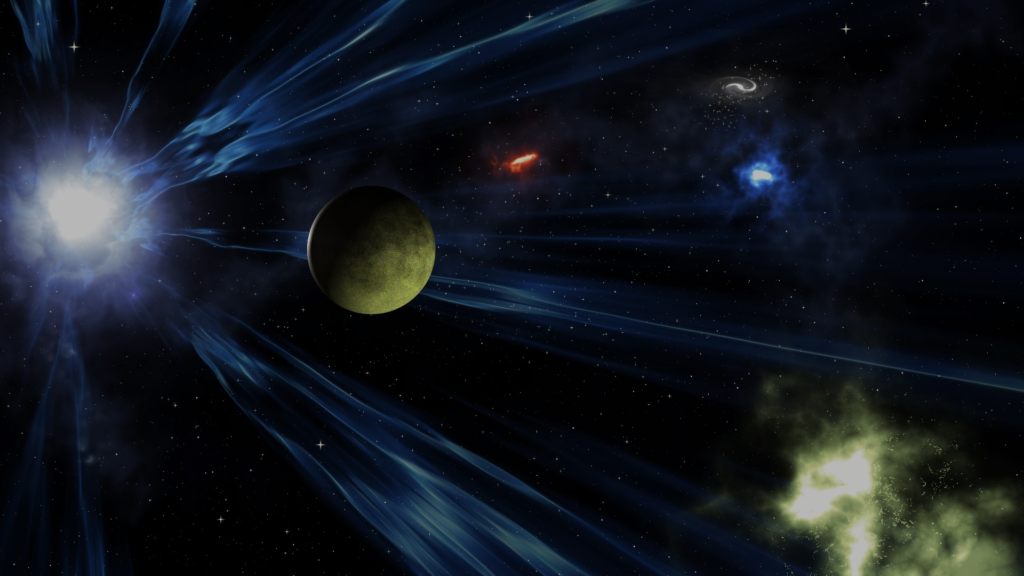## Unraveling the Mysteries of Black Holes: Cosmic Vacuum Cleaners
Have you ever imagined a place where gravity is so strong that not even light can escape? That’s the mind-bending reality of a black hole – a region of spacetime with such intense gravity that nothing, not even the fastest thing in the universe, can break free. Forget science fiction – these cosmic behemoths are real, and they’re rewriting our understanding of the universe. Let’s dive into the fascinating world of black holes!
### 1. How are Black Holes Born? Not with a Bang, But a Collapse!
Black holes aren’t born in a single cataclysmic event. Instead, they are the final stage in the life cycle of massive stars. Imagine a star many times larger than our Sun, burning fiercely through its nuclear fuel. When this fuel runs out, the star’s core collapses under its own immense gravity. This collapse is incredibly powerful, squeezing the star’s matter into an incredibly tiny space.
Think of it like deflating a balloon – except instead of air, you’re squeezing an unimaginable amount of matter into a point smaller than an atom. This point is called a singularity – a place where the laws of physics as we know them break down. The surrounding space is warped by this extreme gravity, creating the black hole’s characteristic event horizon – the point of no return. Cross this boundary, and even light can’t escape!
### 2. The Event Horizon: A One-Way Ticket to… Somewhere?
The event horizon isn’t a physical surface, but rather a boundary defined by the black hole’s gravity. It’s often visualized as a sphere surrounding the singularity. Anything that crosses this boundary – whether it’s a star, a planet, or even a stray photon – is irrevocably trapped. It’s not like falling into a hole; instead, it’s more like being stretched and squeezed by immense tidal forces as you approach the singularity. This process, known as spaghettification, is a rather gruesome fate for anything unfortunate enough to get too close.
### 3. Types of Black Holes: Not All Black Holes are Created Equal
While the basic principle remains the same, black holes come in different sizes. Stellar-mass black holes, formed from the collapse of massive stars, are relatively common. Then there are supermassive black holes, millions or even billions of times more massive than our Sun, residing at the centers of most galaxies, including our own Milky Way. The exact formation mechanism of supermassive black holes is still a subject of ongoing research, but it’s thought that they may grow through the accretion of matter and the merging of smaller black holes. There’s even a theoretical type called intermediate-mass black holes, which are still being actively searched for.
### 4. Observing the Unseeable: How Do We Know They Exist?
You might think it’s impossible to study something that doesn’t even let light escape. However, astronomers have clever ways to detect black holes. They observe the effects of their immense gravity on nearby matter. For instance, we can see stars orbiting an invisible object at incredibly high speeds, indicating the presence of a massive, compact object – a black hole. Also, as matter spirals into a black hole, it heats up and emits intense X-rays, providing another way to detect these cosmic vacuum cleaners.
### 5. Black Holes: A Cosmic Mystery Solved (and Unsolved!)
Black holes are truly remarkable objects. They challenge our understanding of gravity, spacetime, and the very nature of reality. While we’ve made significant progress in understanding their formation and properties, many questions remain. What happens to information that falls into a black hole? How do supermassive black holes form? These are some of the burning questions driving ongoing research in astrophysics.
**Conclusion:**
Black holes, despite their ominous name, are fascinating windows into the extreme physics of our universe. Their existence pushes the boundaries of our scientific understanding and continues to inspire awe and wonder. So next time you look up at the night sky, remember that these incredible objects are out there, silently shaping the cosmos. What do you find most intriguing about black holes? Share your thoughts in the comments below! And for further exploration, check out resources like NASA’s website or explore relevant articles in scientific journals.


